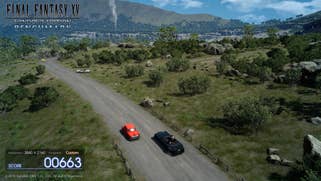Nvidia GeForce RTX 2060 Super/ RTX 2070 Super - the Digital Foundry verdict
Product refresh or preemptive strike?
Nvidia tells us that the Super products were always on the cards and that this release isn't a pre-emptive strike against AMD's upcoming Navi. The original RTX line was originally planned to launch around E3 last year, and this is a planned annual refresh. That said, the firm has form in delivering great products on the eve of a new AMD launch - the GTX 980 Ti's arrival ahead of the Radeon Fury X, for example. Regardless, the end result is a brace of GPUs (with one more to follow) that take the existing Turing cards and power them up, making them more performant while undeniably delivering more value.
The price reductions are welcome, if not revelatory, and so in terms of bang for the buck in standard 3D gaming, we are getting something closer to what many would have liked to have seen last year - RTX features as well as more rendering power for your existing games, all delivered at a cheaper price-point. Could prices have been even lower? Part of the decision-making process here will have been a reaction to the pricing set by AMD for its upcoming RX 5700 and RX 5700 XT, where we genuinely expected disruptive pricing from Team Red - but instead got what amounts to validation that cutting-edge tech isn't cheap. Having played its hand and revealed how Navi stacks up against the first wave of Turing cards, AMD's own benchmarks suggest that Super will be faster for not that much more money - but that's a fascinating confrontation that'll play out later on - July 7th, specifically.
In the meantime, Nvidia made two key claims for each of its new products when bringing the two RTX Super cards to market. The RTX 2060 Super would beat the accomplished GTX 1080, and would do so at a $399 price-point - while at the same time offering up the complete RTX feature set. Meanwhile, the RTX 2070 Super would supplant the GTX 1080 Ti for $100 more than its cheaper Super counterpart, again retaining the Turing tech's forward looking technologies. Our results are obviously a limited set of numbers and other coverage will doubtless cover off more titles, but the indications are that the 2060 Super fully delivers, while the 2070 Super falls just a little short.
That's not to say it's not a good card, however, as plenty of its performance numbers stack up favourably against the Radeon 7 - a card that's a lot more expensive. There's also some canny marketing from Nvidia here - its key marketing messages on performance concentrate on Pascal comparisons, and the sense is that the firm doesn't want to rub salt into the wounds of those who bought into RTX earlier at a price premium. Even performance is carefully weighted. The RTX 2060 Super is to all intents and purposes a replacement for the vanilla 2070, but the numbers reveal that it is just a tiny bit slower overall. Meanwhile, the RTX 2070 Super occupies a performance tier that's around GTX 1080 Ti level, with the existing RTX 2080 still faster overall - but again, the results can be tight. It'll be fascinating to see how the upcoming RTX 2080 Super slots in. Pricing has already been announced there at £669/$699/€739 and it's the only one of the new offerings to use faster GDDR6 memory, with a 1.5gbps upgrade over the existing 14gbps modules used across the RTX line.
Outside of the raw benchmarks, I also think it's important to take a look at the experience that these new cards actually deliver. The RTX 2060 Super is indeed faster than GTX 1080, a card you might consider as a consummate 1440p performer and capable of some good 4K results - especially so with an adaptive sync display. I'd have liked to have seen that delivered at original RTX 2060 pricing, but regardless, it's a good package and a significant price drop for what is essentially an RTX 2070 in performance terms. Meanwhile, the RTX 2070 Super - like Radeon 7 and GTX 1080 Ti - is great for dipping your toes into native resolution 4K gaming, while delivering plenty of muscle for ray traced titles. Its performance is pitched below RTX 2080 (almost certainly by design) but again, it's close enough that simple settings tweaks will get you into the same ballpark.
In the meantime, it's fascinating to look back over the last year to see what the RTX line has achieved. There's no doubt whatsoever that this was a risky launch. Nvidia could have played it safe. The silicon investment in the RT hardware and the tensor cores could so easily have been dedicated to more compute power instead - and many would likely have preferred that the firm did exactly that. But genuine technological innovation requires companies to strike out and deliver innovative new hardware. A fully robust software line-up at launch was always a pipe dream, but since the RTX launch it's been fascinating to chart the progress of real-time ray tracing - a feature that Intel has also announced support for, and that AMD will catch up with in the fullness of time.
Nvidia's introduction of features like DLSS has also been interesting to follow - the tech is viable, but what's clear is that the training algorithms are very much a work in progress with variable results. Meanwhile, there's still the sense that Turing has a lot more to offer, reliant on developer support - variable rate shading looks highly promising while technology like mesh shaders could be a game-changer.
And regardless of how the Navi numbers play out against the Super cards on July 7th, these are aspects that shouldn't be underestimated. The original RTX releases focused on these new features over a price vs performance bump - 'jam tomorrow', if you like, owing to the lack of software support. Across the last few months, the RTX library has expanded, exciting new titles are on the horizon and prices are more reasonable now (our understanding is that RTX 2060 will continue to be sold as an 'entry level' ray tracing card). The RTX 2060 Super and 2070 Super aren't game changers then - but as solid graphics upgrades for your PC priced closer to expectations, they do indeed deliver.


















Nvidia GeForce RTX 2060 Super / RTX 2070 Super Analysis
- Introduction, Hardware Breakdown
- RTX vs RTX Super: Ray tracing performance analysis
- Assassin's Creed Odyssey/Unity, Battlefield 1 - Rasterisation Analysis Part 1
- Crysis 3, Far Cry 5, Ghost Recon Wildlands - Rasterisation Analysis Part 2
- Rise of the Tomb Raider, Shadow of the Tomb Raider, The Witcher 3 - Rasterisation Analysis Part 3
- Nvidia GeForce RTX 2060 Super/ RTX 2070 Super - the Digital Foundry verdict [This Page]
